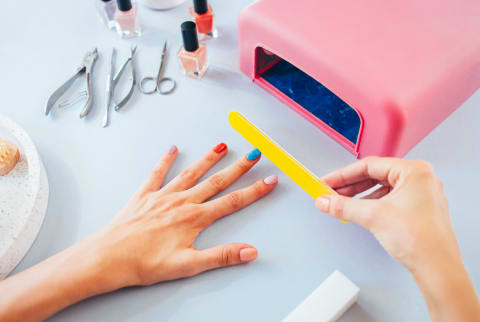Are Gel Manicures Bad For You? What The Pros Want You To Know
If you get gel manis, read this.


Beauty & Health Editor
Beauty & Health Editor
Hannah Frye is the Beauty & Health Editor at mindbodygreen. She has a B.S. in journalism and a minor in women’s, gender, and queer studies from California Polytechnic State University, San Luis Obispo. Hannah has written across lifestyle sections including beauty, women’s health, mental health, sustainability, social media trends, and more. She previously worked for Almost 30, a top-rated health and wellness podcast. In her current role, Hannah reports on the latest beauty trends and innovations, women’s health research, brain health news, and plenty more.
Image by Studio Firma / Stocksy May 26, 2025 We carefully vet all products and services featured on mindbodygreen using our Our selections are never influenced by the commissions earned from our links. There's no right or wrong way to experiment with your nails. You should always put your passions, interests, and preferences before all else. However, some habits can be particularly damaging over time, so it's important to know what you're getting into. Today's topic: gel nails. While this ultra-long-lasting manicure may be great for wearability, your nails may beg to differ. To come, nail experts explain how gel polish affects your nails, how to remove it properly, and what to do if you're left with paper-thin tips.
Why gel nails can be bad for your health
To keep it simple: Yes, your nails are better off on their own than with gel, but you probably already knew that. The reason this gel can be so damaging is related not entirely to the product itself but also the process. Here's what you should know:
1.
The application and removal process is harsh on the nail
"Most of the damage from soak-off gels is due to the removal process," board-certified dermatologist and nail expert Dana Stern, M.D., tells mbg. This includes sanding the nail down before application and the acetone soak for removal.
"A study out of Miami School of Medicine used ultrasound to demonstrate that gel manicures cause nail thinning1," Stern notes. While it is unclear whether the polish or removal process was at fault, Stern notes that most experts align with the latter theory.
Nail expert and owner of Brooklyn-based nail salon Lunula Tina Wang agrees: "Proper gel removal is often what makes the difference between maintaining or damaging nails," she notes.
The reason gel nails cause dryness is due to a couple of different culprits, she says, including forcefully scraping off product during removal (instead of allowing it to release first), aggressive filing after removal, and picking and peeling off the gel polish.
3.
UV lights cause DNA damage
Research found that radiation emitted by UV-nail polish dryers can alter and damage DNA2—however, it's not clear if this is associated with skin cancers or other health risks. "At this point in time, it is difficult to quantify the risks of UVA exposure during repeated gel manicure sessions," Stern says. There's much variability with respect to types of lamps, exposure times, positioning of skin, skin types, etc.
"We do know that repeated exposure to UVA from sunlight or tanning machines is mutagenic and can cause skin cancer, the question remains as to how much of a risk typical gel manicures pose2," she adds—which means we need more studies to confirm the risk.
But, we do know that UVA rays contribute to photoaging. "UVA rays penetrate the skin to a deeper depth than UVB rays and as a result are responsible for many of the changes in the skin known as photoaging," she says. This includes thinning and wrinkling of the skin, visible blood vessels, uneven skin tone, skin laxity, volume loss, hyperpigmentation (aka dark spots), and hypopigmentation (aka light spots).
So if you must get a gel manicure, Stern recommends applying SPF 30 to your hands or wearing fingerless gloves before popping them under the light.
4.
It dries out the cuticle
"Long acetone soaks can also cause dehydration of the cuticle," Stern notes. "Dry cuticles can retract, lift and separate, and lead to a compromise to the nail's natural protective barrier," she says.
Of course you can replenish hydration via hand cream and cuticle oil after your manicure, but repeated exposure to potent acetone might take a toll over time regardless.
5.
It can be left on too long
When you think of the benefits of gel nails, you probably come across the fact that they last much longer than typical polish in most cases. However, that might not be a great thing for your nail health.
"You should not leave a gel manicure on for longer than two to three weeks, even if it still looks intact," Wang says. "The extra weight can start pulling on your nail, causing tears in the base of your nails," she adds.
6.
It can cause keratin granulation
"Additionally when gels are removed, superficial layers of nail cells can be inadvertently removed along with the gel, and this can result in the formation of a keratin granulation," Stern says.
"Keratin granulations appear as white patches in the nail and can also occur when polish is left on too long and then removed," she adds. So if you've seen white spots on your nails, it may be due to frequent gel manicures.
How to remove gel nails at home
If all of that has you convinced you should remove your gel ASAP, don't move too quickly. The experts agree it's always best practice to get your gel removed by a professional.
However, you can do it at home if you don't have access to a nail tech—here's how:
Healthy nail tips
After you remove your gel polish, your nails will probably be frail for a little while. The good news is that your nails can make a full recovery, but it will take some time and dedicated nail care to nurse them back to health. Consider these steps:
Gel alternatives
If you love the longevity and durability of gels, there are other options to use. Here, some to check out.
FAQ
What is so bad about gel nails?
"Most of the damage from soak-off gels is due to the removal process," board-certified dermatologist and nail expert Dana Stern, M.D., tells mbg. This includes sanding the nail down before application and the acetone soak for removal. However, the UV light used during the application and weight of the gel can take a toll on your nails as well.
Are gel nails worse than acrylic?
Both gel nails and acrylic nails have an aggressive application and removal process that includes intense filing and often ripping off the gel polish or acrylic nail, which can contribute to breakage. In addition, acrylic and gel nails are often removed using acetone, which can be drying to the nail and cuticle, resulting in brittleness and breakage, especially when used over time.
The takeaway
While there are many things out there that are worse for you than gel nail polish, it's certainly not great for your tips. Most of the damage comes from the aggressive and drying removal and application process, but UVA light exposure can't be ignored, either.
If you're ready to remove your gel, do so gently and avoid aggressively pulling the gel off too soon. Your nails might be frail afterward, but they will grow back in time—especially if you follow these tips.

 FrankLin
FrankLin 






























